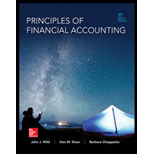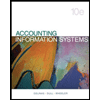
Principles of Financial Accounting.
22nd Edition
ISBN: 9780077632892
Author: John J. Wild
Publisher: McGraw Hill
expand_more
expand_more
format_list_bulleted
Concept explainers
Question
Chapter 11, Problem 11DQ
To determine
Explain whether the company should report a probable loss from future disaster as a liability on its
Expert Solution & Answer
Want to see the full answer?
Check out a sample textbook solution
Students have asked these similar questions
Solve my problem with accounting
Please provide the correct solution to this financial accounting question using valid principles.
Need answer
Chapter 11 Solutions
Principles of Financial Accounting.
Ch. 11 - On December 1, a company signed a 6,000, 90-day,...Ch. 11 - Prob. 2MCQCh. 11 - Prob. 3MCQCh. 11 - Prob. 4MCQCh. 11 - Prob. 5MCQCh. 11 - Prob. 1DQCh. 11 - Prob. 2DQCh. 11 - What are the three important questions concerning...Ch. 11 - Prob. 4DQCh. 11 - Prob. 5DQ
Ch. 11 - Prob. 6DQCh. 11 - Prob. 7DQCh. 11 - Prob. 8DQCh. 11 - Prob. 9DQCh. 11 - Prob. 10DQCh. 11 - Prob. 11DQCh. 11 - Prob. 12DQCh. 11 - What amount of income tax is withheld from the...Ch. 11 - Prob. 14DQCh. 11 - Prob. 15DQCh. 11 - Prob. 16DQCh. 11 - Refer to Samsungs recent balance sheet in Appendix...Ch. 11 - Prob. 1QSCh. 11 - Prob. 2QSCh. 11 - Prob. 3QSCh. 11 - Prob. 4QSCh. 11 - Prob. 5QSCh. 11 - Prob. 6QSCh. 11 - Prob. 7QSCh. 11 - Prob. 8QSCh. 11 - Prob. 9QSCh. 11 - Prob. 10QSCh. 11 - Prob. 11QSCh. 11 - Prob. 12QSCh. 11 - Prob. 13QSCh. 11 - Prob. 14QSCh. 11 - Prob. 1ECh. 11 - Prob. 2ECh. 11 - Prob. 3ECh. 11 - Prob. 4ECh. 11 - Prob. 5ECh. 11 - Prob. 6ECh. 11 - Prob. 7ECh. 11 - Prob. 8ECh. 11 - Prob. 9ECh. 11 - Prob. 10ECh. 11 - Prob. 11ECh. 11 - Prob. 12ECh. 11 - Prob. 13ECh. 11 - Prob. 14ECh. 11 - Prob. 15ECh. 11 - Prob. 16ECh. 11 - Prob. 17ECh. 11 - Prob. 18ECh. 11 - Prob. 1APCh. 11 - Prob. 2APCh. 11 - Prob. 3APCh. 11 - Prob. 4APCh. 11 - Prob. 5APCh. 11 - Prob. 6APCh. 11 - Prob. 1BPCh. 11 - Prob. 2BPCh. 11 - Prob. 3BPCh. 11 - Prob. 4BPCh. 11 - Prob. 5BPCh. 11 - Prob. 6BPCh. 11 - Prob. 11SPCh. 11 - Prob. 1BTNCh. 11 - COMPARATIVE ANALYSIS
BTN 9-2 Key figures for Apple...Ch. 11 - Beyond the Numbers Cameron Bly is a sales manager...Ch. 11 - Prob. 4BTNCh. 11 - Prob. 5BTNCh. 11 - Prob. 7BTNCh. 11 - Prob. 9BTN
Knowledge Booster
Learn more about
Need a deep-dive on the concept behind this application? Look no further. Learn more about this topic, accounting and related others by exploring similar questions and additional content below.Similar questions
- What was the amount of Swift Corporation's bad debt expense for the year?arrow_forwardWhat is the gross margin for the first year?arrow_forwardThe Natasha Manufacturing's cost of goods manufactured was $185,000 when its sales were $420,000 and its gross margin was $195,000. If the ending inventory of finished goods was $48,000, the beginning inventory of finished goods must have been__.arrow_forward
- The storekeeper at Charles Resort conducted the monthly cleaning supply inventory. Records showed an opening balance of 720 units, with deliveries of 310 units and consumption recorded at 650 units during the month. Physical verification found 365 units in stock. The operations manager requested the quantity variance report.arrow_forwardProvide answerarrow_forwardTorrance Industries has the following information concerning its direct materials:arrow_forward
arrow_back_ios
SEE MORE QUESTIONS
arrow_forward_ios
Recommended textbooks for you
 Intermediate Accounting: Reporting And AnalysisAccountingISBN:9781337788281Author:James M. Wahlen, Jefferson P. Jones, Donald PagachPublisher:Cengage Learning
Intermediate Accounting: Reporting And AnalysisAccountingISBN:9781337788281Author:James M. Wahlen, Jefferson P. Jones, Donald PagachPublisher:Cengage Learning Auditing: A Risk Based-Approach (MindTap Course L...AccountingISBN:9781337619455Author:Karla M Johnstone, Audrey A. Gramling, Larry E. RittenbergPublisher:Cengage Learning
Auditing: A Risk Based-Approach (MindTap Course L...AccountingISBN:9781337619455Author:Karla M Johnstone, Audrey A. Gramling, Larry E. RittenbergPublisher:Cengage Learning Financial Reporting, Financial Statement Analysis...FinanceISBN:9781285190907Author:James M. Wahlen, Stephen P. Baginski, Mark BradshawPublisher:Cengage Learning
Financial Reporting, Financial Statement Analysis...FinanceISBN:9781285190907Author:James M. Wahlen, Stephen P. Baginski, Mark BradshawPublisher:Cengage Learning Cornerstones of Financial AccountingAccountingISBN:9781337690881Author:Jay Rich, Jeff JonesPublisher:Cengage Learning
Cornerstones of Financial AccountingAccountingISBN:9781337690881Author:Jay Rich, Jeff JonesPublisher:Cengage Learning Pkg Acc Infor Systems MS VISIO CDFinanceISBN:9781133935940Author:Ulric J. GelinasPublisher:CENGAGE L
Pkg Acc Infor Systems MS VISIO CDFinanceISBN:9781133935940Author:Ulric J. GelinasPublisher:CENGAGE L

Intermediate Accounting: Reporting And Analysis
Accounting
ISBN:9781337788281
Author:James M. Wahlen, Jefferson P. Jones, Donald Pagach
Publisher:Cengage Learning

Auditing: A Risk Based-Approach (MindTap Course L...
Accounting
ISBN:9781337619455
Author:Karla M Johnstone, Audrey A. Gramling, Larry E. Rittenberg
Publisher:Cengage Learning

Financial Reporting, Financial Statement Analysis...
Finance
ISBN:9781285190907
Author:James M. Wahlen, Stephen P. Baginski, Mark Bradshaw
Publisher:Cengage Learning

Cornerstones of Financial Accounting
Accounting
ISBN:9781337690881
Author:Jay Rich, Jeff Jones
Publisher:Cengage Learning

Pkg Acc Infor Systems MS VISIO CD
Finance
ISBN:9781133935940
Author:Ulric J. Gelinas
Publisher:CENGAGE L
